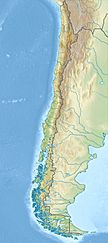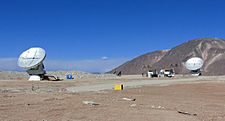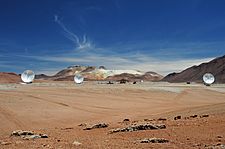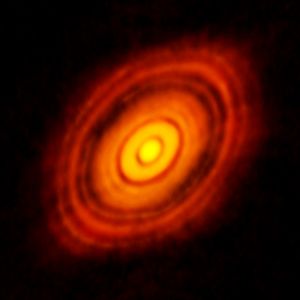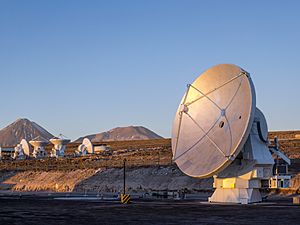Atacama Large Millimeter Array facts for kids
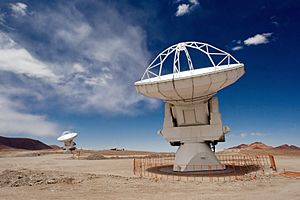 |
|
| Alternative names | Atacama Large Millimeter and Submillimeter Array |
|---|---|
| Part of | Event Horizon Telescope Llano de Chajnantor Observatory |
| Location(s) | Atacama Desert, Antofagasta Region, Atacama Desert, Chile |
| Coordinates | 23°01′09″S 67°45′12″W / 23.0193°S 67.7532°W |
| Organization | European Southern Observatory National Institutes of Natural Sciences, Japan National Science Foundation |
| Altitude | 5,058.7 m (16,597 ft) |
| Built | March 2013 |
| Telescope style | radio interferometer |
| Website | www |
The Atacama Large Millimeter/submillimeter Array (ALMA) is a huge group of 66 radio telescopes located in the Atacama Desert in northern Chile. These telescopes work together like one giant telescope. They observe special kinds of light called millimeter and submillimeter wavelengths, which our eyes cannot see.
ALMA is built on the Chajnantor plateau, which is about 5,000 meters (16,400 feet) high. This location is perfect because it is very high up and has very dry air. These conditions help reduce noise and make sure the signals from space are clear. ALMA helps scientists learn how stars were born long ago and how new stars and planets are forming today.
ALMA is a project that involves many countries, including Europe, the United States, Canada, Japan, South Korea, Taiwan, and Chile. It cost about US$1.4 billion, making it the most expensive telescope on the ground. ALMA started its scientific work in 2011 and has been fully working since March 2013.
Contents
What is ALMA?
The ALMA telescope system has 66 very precise antennas. These antennas can detect light with wavelengths from 3.6 to 0.32 millimeters. This means ALMA can see things that older telescopes could not. It is much more sensitive and can see much finer details than other submillimeter telescopes.
How ALMA Works
ALMA uses a special technique called interferometry. This means all the antennas work together as if they were one giant telescope. By combining the signals from many antennas, ALMA can create very sharp images of distant objects in space.
The antennas can be moved across the desert plateau. They can be as close as 150 meters (490 feet) apart or as far as 16 kilometers (10 miles) apart. This ability to change the distance between antennas gives ALMA a powerful "zoom" feature. It is similar to how a camera lens can zoom in and out.
The main reason ALMA is so sensitive is because it uses so many antennas. More antennas mean more light can be collected, leading to clearer and more detailed images.
Who Built ALMA's Antennas?
The different parts of ALMA were built by its international partners. The European and North American partners each provided 25 large antennas, each 12 meters (39 feet) wide. This makes up the main part of the array, with 50 antennas.
The East Asian countries, including Japan, South Korea, and Taiwan, added 16 more antennas. These include four 12-meter antennas and twelve smaller 7-meter (23 feet) antennas. This group of smaller antennas is called the Atacama Compact Array (ACA).
The ACA uses smaller antennas placed closer together. This helps ALMA see larger areas of the sky at once. The ACA works with the main array to improve its ability to capture wide-field images.
Amazing Discoveries with ALMA
ALMA has helped scientists make many important discoveries about space.
First Images from ALMA
In 2011, during its testing phase, ALMA captured its first images. These early pictures showed how powerful the new telescope would be. The first target was a pair of galaxies crashing into each other, known as the Antennae Galaxies.
ALMA's image of the Antennae Galaxies was the best ever taken at submillimeter wavelengths. It showed huge clouds of cold gas where new stars are forming. These gas clouds cannot be seen with regular visible light telescopes like the Hubble Space Telescope.
Studying Comets
In 2014, astronomers used ALMA to study comets for the first time. They looked at comets C/2012 F6 (Lemmon) and C/2012 S1 (ISON). ALMA helped them map out different gases and dust inside the fuzzy cloud around the comet, called the coma.
How Planets Form
One of ALMA's most exciting discoveries came in 2014. It captured an image of a protoplanetary disc around a very young star called HL Tauri. This disc is where planets are born. The image showed clear rings and gaps in the disc. This suggests that young planets were already forming and clearing paths in the dust and gas.
Before this, scientists thought it would take much longer for planets to form in such a young star system. This discovery made scientists rethink how quickly planets can grow.
Seeing a Black Hole
ALMA was a key part of the Event Horizon Telescope project. In 2019, this project made history by producing the first direct image of a black hole. ALMA's powerful antennas helped collect the data needed to create this groundbreaking image.
Looking for Life on Venus
ALMA also played a role in a discovery about phosphine gas in the atmosphere of Venus. Phosphine is a gas that, on Earth, is often linked to living things. While the detection of phosphine on Venus is still being debated by scientists, ALMA's observations were important in this search for signs of life beyond Earth.
ALMA's Journey: A Timeline
ALMA has been a long project, taking many years to build and get ready. Here are some important dates:
| Date | Activity |
|---|---|
| 1995 | Scientists started looking for the best place to build ALMA in Chile. |
| May 1998 | The first phase of designing and developing ALMA began. |
| February 2003 | Europe and North America signed an agreement to fund ALMA. |
| April 2003 | The first test antenna started working in New Mexico, USA. |
| November 2003 | Construction officially began at the ALMA site in Chile. |
| September 2004 | Japan joined the project, planning to add more antennas. |
| September 2005 | Taiwan became part of the ALMA Project through Japan. |
| April 2007 | The very first ALMA antenna arrived in Chile. |
| February 2008 | The two special ALMA transporters, which move the antennas, arrived in Chile. |
| May 2009 | Two antennas worked together for the first time to observe space. |
| September 2009 | The first ALMA antenna was moved to the high Chajnantor plateau. |
| September 2011 | ALMA began its "Early Science" phase, with 16 antennas working. |
| March 13, 2013 | ALMA was officially opened in a special ceremony. |
| September 23, 2013 | The 66th and final antenna was delivered and ready to use. |
| March 2020 | ALMA temporarily closed due to the COVID-19 pandemic. |
Images for kids
See also
 In Spanish: Atacama Large Millimeter Array para niños
In Spanish: Atacama Large Millimeter Array para niños


